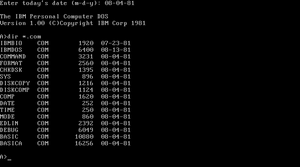Software:Edlin
| Original author(s) | Tim Paterson |
|---|---|
| Developer(s) | Microsoft, IBM, Gregory Pietsch |
| Initial release | 1980 |
| Written in | MS-DOS: x86 assembly language |
| Operating system | 86-DOS, IBM PC DOS, MS-DOS, FreeDOS, OS/2, eComStation, ArcaOS, Windows |
| Type | Line editor |
| License | MS-DOS: MIT FreeDOS, ReactOS: GPL 86-DOS, PC DOS, OS/2, Windows: Proprietary commercial software |
| Website | Edlin |
Edlin is a line editor, and the only text editor provided with early versions of IBM PC DOS,[1] MS-DOS and OS/2.[2] Although superseded in MS-DOS 5.0 and later by the full-screen MS-DOS Editor, and by Notepad in Microsoft Windows, it continues to be included in the 32-bit versions of current Microsoft operating systems.
History

Edlin was created by Tim Paterson in two weeks in 1980, for Seattle Computer Products's 86-DOS (QDOS)[3] based on the CP/M context editor ED,[4][5] itself a distant derivative of the Unix ed line editor.
Microsoft acquired 86-DOS and, after some further development, sold it as MS-DOS, so Edlin was included in v1.0–v5.0 of MS-DOS. From MS-DOS 6 onwards, the only editor included was the new full-screen MS-DOS Editor.
Windows 95, 98 and ME ran on top of an embedded version of DOS, which reports itself as MS-DOS 7. As a successor to MS-DOS 6, this did not include Edlin.
However, Edlin is included in the 32-bit versions of Windows NT[6] and its derivatives—up to and including Windows 10—because the NTVDM's DOS support in those operating systems is based on MS-DOS version 5.0. However, unlike most other external DOS commands, it has not been transformed into a native Win32 program. It also does not support long filenames, which were not added to MS-DOS and Windows until long after Edlin was written.
The FreeDOS version was developed by Gregory Pietsch.[7]
Usage
There are only a few commands. The short list can be found by entering a ? at the edlin prompt.
When a file is open, typing L lists the contents (e.g., 1,6L lists lines 1 through 6). Each line is displayed with a line number in front of it.
*1,6L
1: Edlin: The only text editor in early versions of DOS.
2:
3: Back in the day, I remember seeing web pages
4: branded with a logo at the bottom:
5: "This page created in edlin."
6: The things that some people put themselves through. ;-)
The currently selected line has a *. To replace the contents of any line, the line number is entered and any text entered replaces the original. While editing a line pressing Ctrl-C cancels any changes. The * marker remains on that line.
Entering I (optionally preceded with a line number) inserts one or more lines before the * line or the line given. When finished entering lines, Ctrl-C returns to the edlin command prompt.
*6I
6:*(...or similar)
7:*^C
*7D
*L
1: Edlin: The only text editor in early versions of DOS.
2:
3: Back in the day, I remember seeing web pages
4: branded with a logo at the bottom:
5: "This page created in edlin."
6: (...or similar)
- i - Inserts lines of text.
- D - deletes the specified line, again optionally starting with the number of a line, or a range of lines. E.g.:
2,4ddeletes lines 2 through 4. In the above example, line 7 was deleted.
- R - is used to replace all occurrences of a piece of text in a given range of lines, for example, to replace a spelling error. Including the ? prompts for each change. E.g.: To replace 'prit' with 'print' and to prompt for each change:
?rprit^Zprint(the ^Z represents pressing CTRL-Z). It is case-sensitive.
- S - searches for given text. It is used in the same way as replace, but without the replacement text. A search for 'apple' in the first 20 lines of a file is typed
1,20?sapple(no space, unless that is part of the search) followed by a press of enter. For each match, it asks if it is the correct one, and accepts n or y (or Enter).
- P - displays a listing of a range of lines. If no range is specified, P displays the complete file from the * to the end. This is different from L in that P changes the current line to be the last line in the range.
- T - transfers another file into the one being edited, with this syntax: [line to insert at]t[full path to file].
- W - (write) saves the file.
- E - saves the file and quits edlin.
- Q - quits edlin without saving.
Scripts
Edlin may be used as a non-interactive file editor in scripts by redirecting a series of edlin commands.
edlin < script
FreeDOS Edlin
A GPL-licensed clone of Edlin that includes long filename support is available for download as part of the FreeDOS project. This runs on operating systems such as Linux or Unix as well as MS-DOS.[8]
See also
- List of DOS commands
- ed and ex, similar Unix line editors.
- 86-DOS
References
- ↑ "Disk Operating System". January 1982. http://www.bitsavers.org/pdf/ibm/pc/dos/6172220_DOS_1.0_Jan82.pdf.
- ↑ "OS/2 1.0". http://www.os2museum.com/wp/os2-history/os2-1-0/.
- ↑ "A Short History of MS-DOS". http://www.patersontech.com/dos/byte%E2%80%93history.aspx.
- ↑ "ED Utility". Archived from the original. Error: If you specify
|archiveurl=, you must also specify|archivedate=. https://web.archive.org/web/20130620002545/http://www.shaels.net/index.php/cpm80-22-documents/using-cpm/8-ed-utility. - ↑ "ED: A Context Editor for The CP/M Disk System". 1978. https://archive.org/details/bitsavers_digitalResrsManual1978_1058478.
- ↑ 16-Bit Applications Included with Windows NT, Microsoft.com
- ↑ "FreeDOS Package -- edlin (FreeDOS Base)". http://www.ibiblio.org/pub/micro/pc-stuff/freedos/files/distributions/1.2/repos/pkg-html/edlin.html.
- ↑ "FreeDOS Edlin". 3 March 2023. http://sourceforge.net/projects/freedos-edlin.
Further reading
- Microsoft Operating System/2 User's Reference. Microsoft. 1987. http://www.os2museum.com/wp/wp-content/uploads/2011/12/1987-Oct-OS2-1.0-Users_Reference.pdf.
External links
- Edlin | Microsoft Docs
- MS-DOS edlin command help
- Open source EDLIN implementation that comes with MS-DOS v2.0
 |


